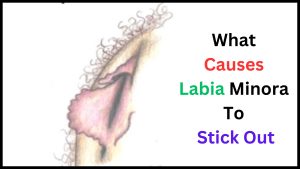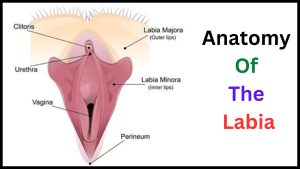
Have you ever wondered why some women ask “What Causes Labia Minora To Stick Out”?
It’s a natural and normal variation in the female anatomy, but there can be a few factors that contribute to this occurrence.
Hormonal changes during puberty, genetics, and certain medical conditions can all play a role in the length and appearance of the labia minora.
It’s important to remember that there is no right or wrong way for your labia minora to look, as every woman is beautifully unique in her own way.
Table of Contents
What Causes Labia Minora To Stick Out: Discover the reasons
Introduction
The labia minora are an important part of a woman’s anatomy, and they come in a variety of shapes and sizes.
While there is no such thing as a “normal” labia size, some women may find that their labia minora sticks out more than they would like.
This can often cause discomfort or self-consciousness.
In this article, we will explore the factors that can contribute to labia minora sticking out and discuss various options available for those seeking a solution.

Anatomy of the Labia Minora
The labia minora, also known as the inner lips of the vulva, are an important part of female genitalia.
They are small, thin folds of skin that lie on either side of the vaginal opening.
Despite their small size, the labia minora play a vital role in sexual arousal and protection of the delicate vaginal tissues.
Understanding the structure and function of the labia minora is essential in appreciating their normal variations and the factors that can influence their size and appearance.
Structure and Function of the Labia Minora
The labia minora are composed of specialized skin that contains sweat glands, sebaceous glands, and hair follicles.
They are richly supplied with blood vessels and nerve endings, which contribute to their sensitivity.
Also, the labia minora serves multiple functions, including protection of the vaginal opening and clitoris, as well as lubrication during sexual arousal.
They also contribute to the overall aesthetics of the vulva.
Normal Variations in Labia Minora Size
It is important to recognize that there is a wide range of normal variations in labia minora size and appearance.
Just like individuals have different eye colors or hair textures, labia minora can also have distinct variations.
Some women have labia minora that are barely visible, while others have labia minora that extend beyond the labia majora (outer lips).
These variations are completely normal and not indicative of any underlying medical condition.
Embracing the natural diversity of labia minora is crucial in promoting body positivity and reducing unnecessary concerns.
What Causes Labia Minora To Stick Out
Below are some of the causes:
1. Hormonal Imbalance
2. Genetics
3. Childbirth
4. Aging
5. Sexual Activity
6. Labial Trauma
7. Obesity
8. Hormonal Changes
9. Pregnancy and Swelling
10. Medical Conditions
1. Hormonal Imbalance
Hormonal imbalance can play a significant role in the appearance of the labia minora.
Two specific hormonal imbalances that can affect the labia are estrogen dominance and low estrogen levels.
Estrogen dominance occurs when there is an excess of estrogen relative to progesterone in the body.
This imbalance can cause the labia minora to grow and protrude.
On the other hand, low estrogen levels can result in the labia becoming smaller and less pronounced.
In women, hormonal changes during different stages of life can also impact the size and shape of the labia.
Puberty, for example, brings about significant hormonal fluctuations and can lead to labial growth and protrusion.
Similarly, during menopause, there is a decline in hormone levels, including estrogen, which can cause the labia to decrease in size or become less prominent.
2. Genetics
Genetics also play a crucial role in determining the size and shape of the labia minora.
Just as hair color and eye color are inherited traits, the appearance of the labia can also be influenced by genetic factors.
The size and shape of the labia are unique to each individual, and variations can be observed based on familial traits and genetic predispositions.
Additionally, certain ethnicities may have a higher prevalence of labia minora that stick out.
Inherited Traits and Labia Minora Development
It is not uncommon for labia minora size and appearance to resemble those of close family members.
Labial characteristics can be inherited, meaning that individuals may share similarities in their labia minora with their mothers, sisters, or other relatives.
Just as with any inherited trait, there can be variations in these characteristics even among family members.
However, inherited traits provide a basis for understanding potential similarities or differences in labia minora size within families.

3. Childbirth and Hormonal Changes
Childbirth is a transformative experience for women, and it can have an impact on the size and appearance of the labia minora.
Stretching of Labia Minora during Vaginal Delivery
During vaginal delivery, the labia minora can undergo stretching and elongation due to the pressure exerted on the vaginal tissues.
This is a normal physiological response to accommodate the passage of the baby through the birth canal.
The labia minora may not return to their pre-pregnancy state immediately after childbirth, but they often regain their normal size and appearance over time.
Also, the act of giving birth puts substantial pressure on the pelvic area, which can lead to changes in the size and shape of the labia.
The stretching can result in labial protrusion or changes in the overall appearance of the labia minora.
Effects of Hormonal Changes on Labia Minora Postpartum
After childbirth, there are significant hormonal changes that occur in the body.
Estrogen levels, in particular, decrease following delivery.
These hormonal fluctuations can affect the appearance and elasticity of the labia minora.
Some women may notice that their labia minora appear larger or have a different shape following childbirth.
However, these changes are usually temporary, and the labia minora often return to their pre-pregnancy appearance as hormone levels stabilize.
4. Aging and Hormonal Changes
As women age, hormonal changes can occur that impact various aspects of their health, including the labia minora.
Effects of Decreased Estrogen Levels on Labia Minora
With age, there is a natural decline in estrogen levels, particularly during and after menopause.
These hormonal changes can lead to a decrease in the size and elasticity of the labia minora.
The labia minora may appear to shrink or recede compared to their pre-menopausal state.
Tissue Atrophy and Labia Minora Changes
Hormonal changes associated with aging can contribute to a condition known as genital tissue atrophy.
This condition involves a thinning and drying of the vaginal tissues, including the labia minora.
As a result, the labia minora may become less prominent or appear smaller in size.
It is important to discuss any concerns about labia minora changes with a healthcare provider for appropriate evaluation and management options.
5. Sexual Activity
Sexual activity, particularly frequent or rough sexual intercourse, can have an impact on the labia minora.
The repeated friction and stretching during sexual intercourse can cause the labia to become more prominent and stick out.
Stretching of the labia can also occur due to the use of certain sexual toys or prolonged and intense sexual activity.
While these changes are usually temporary, they can contribute to a temporarily altered appearance of the labia minora.
6. Labial Trauma or Injury
Trauma or injury to the labia minora can have both immediate and long-term effects on their appearance and function.
Accidental Injuries to the Labia Minora
Accidental injuries, such as cuts or tears, can occur to the labia minora during various activities, including sports, childbirth, or sexual intercourse.
These injuries can result in changes to the size or shape of the labia minora, as well as potential scarring or discomfort.
Long-term Effects on Labia Minora Appearance
Severe trauma or injuries to the labia minora can have long-term effects on their appearance.
Scarring or tissue damage may alter the size, shape, or texture of the labia minora.
In such cases, surgical intervention or other medical treatments may be considered to address any functional or aesthetic concerns.
It is important to seek medical attention if you experience any trauma or injuries to the labia minora to ensure appropriate care and management.
Additionally, piercings or jewelry worn in the labia can cause constant pressure or stretching, potentially leading to changes in the labial appearance.

7. Obesity
Obesity can contribute to the sticking out of the labia minora.
Excess fat deposits in the pubic area can put increased pressure on the labia, causing them to protrude.
The excess weight can also lead to increased friction and rubbing, which can further contribute to labial changes.
This can include activities such as cycling or horseback riding.
Over time, these repeated actions can lead to changes in the size, shape, or sensitivity of the labia minora.
Individuals experiencing discomfort or concerns related to the labia minora should seek medical advice for further evaluation and support.
Also, maintaining a healthy body weight can help alleviate some of these issues.
8. Hormonal Changes
Hormonal changes associated with pregnancy, menstruation, and conditions like polycystic ovary syndrome (PCOS) can impact the appearance of the labia minora.
During pregnancy, the body undergoes significant hormonal fluctuations, which can lead to labial growth and protrusion.
Similarly, hormonal changes during the menstrual cycle can cause temporary changes in the size and shape of the labia.
PCOS, a hormonal disorder characterized by irregular periods and high levels of male hormones, can also contribute to alterations in the labial appearance.
Hormonal Changes During Puberty
Puberty is a period of hormonal fluctuations, particularly an increase in estrogen levels.
Estrogen is the main female sex hormone responsible for the development of secondary sexual characteristics, including breast development, growth of pubic hair, and the enlargement of the labia minora.
As a result of increased estrogen levels, the labia minora may undergo growth and become more prominent.
Effect of Increased Estrogen Levels on Labia Minora
The increase in estrogen during puberty stimulates the growth and elongation of the labia minora.
This growth is a normal part of sexual development and is not considered abnormal or concerning.
It is important to note that the size and appearance of the labia minora can vary greatly between individuals, even within the same age group.
The influence of hormonal changes on the labia minora is temporary and typically stabilizes after puberty.

9. Pregnancy and Swelling
Pregnancy is a time of significant physiological changes, and it can also influence the size and appearance of the labia minora.
Increased Blood Flow and Fluid Retention during Pregnancy
During pregnancy, there is an increase in blood flow to the genital area to support the growing fetus.
This increased blood flow, combined with hormonal changes, can result in fluid retention and swelling in various parts of the body, including the labia minora.
As a result, some pregnant women may notice that their labia minora appear larger or feel more swollen.
Potential Impact on Labia Minora Size
The swelling or enlargement of the labia minora during pregnancy is typically temporary and resolves after childbirth.
However, in rare cases, some women may experience persistent swelling or changes in the size of their labia minora.
If this occurs, it is important to consult a healthcare professional for an evaluation and appropriate management.
10. Medical Conditions
Certain medical conditions can cause changes in the labia minora.
Lichen sclerosus, a chronic inflammatory skin condition, can lead to thinning and tightening of the labial tissues.
This can result in changes in the appearance and texture of the labia.
Lichen planus, another inflammatory condition, can also affect the labia and cause changes in its appearance.
Additionally, hypertrophy, a condition characterized by excessive tissue growth, can lead to an increase in the size of the labia minora.
Labial hypertrophy refers to the excessive or abnormal growth of the labia minora.
This condition can be congenital or acquired and may result from hormonal imbalances, chronic irritation, or certain medical conditions.
Labial hypertrophy can impact the individual’s comfort, sexual function, and overall well-being.
Treatment options, such as labiaplasty (surgical alteration of the labia minora), may be considered to address functional or aesthetic concerns and improve quality of life.
Labiaplasty and Surgical Alteration of the Labia Minora
Labiaplasty is a surgical procedure that involves altering the size or shape of the labia minora.
It is typically performed for cosmetic reasons or to alleviate physical discomfort.
Labiaplasty is a highly individualized procedure that should be discussed with a qualified healthcare provider or plastic surgeon.
It is important to have a thorough understanding of the potential risks, benefits, and outcomes before considering any surgical intervention.
Conclusion
So, what causes labia minora to stick out?
The appearance of the labia minora can be influenced by a variety of factors.
Hormonal imbalances, genetic predispositions, childbirth, aging, sexual activity, labial trauma, obesity, hormonal changes, and medical conditions can all contribute to the sticking out of the labia.
It is important to remember that there is significant variation in the appearance of the labia among individuals, and what may be considered normal and aesthetically pleasing varies from person to person.
If you have concerns about the appearance of your labia or experience any symptoms, it is always advisable to consult with a healthcare professional who can provide personalized guidance and support.
